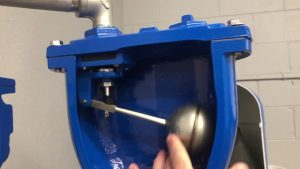There are many processes when it comes to manufacturing metal components and products. The metal fabrication process includes cutting, folding, welding, machining, punching, stamping, shearing, casting, and forging. However, while many of these reshape the alloy, only casting and forging manipulate the shape of the metal at the interior level, allowing for a more significant reshaping of the metal.
The key differences between casting and forging are as follows:
- Casting is the process in which metal is heated in a furnace until molten. While in the liquid state, the metal is poured into a die, or mold, to create a component shape.
- Forging is the process in which thermal and mechanical energy is applied to ingots to cause the alloy to change shape while in a solid state.
What is Forging?
Forging is a kind of process that uses metal forming machinery pressed to metal billet, making it deform plastically to acquire mechanical properties, shape, and size. Forging is a common forming process widely utilized in machinery. Forging can eliminate cast loose and welding holes inside the metal. The mechanical properties of forging are more excellent than castings.
Based on temperature, forging can be classified into cold forging and hot forging. Generally, cold forging is in progress under room temperature. Hot forging is conducted under a temperature that is higher than the recrystallization temperature of the metal. The forging whose temperature is lower than recrystallization is called warm forging.
Advantages of Forging
- Generally tougher than alternatives
- Will handle impact better than castings
- The nature of forging excludes the occurrence of porosity, shrinkage, cavities, and cold pour issues.
- The tight grain structure of forgings makes them mechanically strong. There is less need for expensive alloys to attain high-strength components.
- The tight grain structure offers great wear resistance without the need to make products “superhard” We have found that on a blank HRC 38-42 forged grinder insert wear/wash is about the same as a high alloy HRC 46-50 cast grinder insert. The difference being an HRC 46-50 casting does not have the ductility to handle high-impact grinding.
What is Casting?
Casting is a kind of injection molding, injecting molten liquid metal into a prepared mold. It forms castings after cooling. Based on technique, casting can be classified into sand casting, pressure casting, investment casting, shell mold casting, cavityless casting, low-pressure casting, gravity casting, etc.
Advantages of Casting
- No real upper size limit in casting weight
- Large range of alloy choices
- As forgings remain solid, custom alloys are far more difficult to get into production whereas, with casting, alloys including Chrome, Nickel, and Moly can be added at the molten stage.
- Tooling is often less expensive than forge dies
- Smaller production “runs” required
- Complicated/complex parts are no problem
Forging vs Casting
To summarize, castings are melted, poured, and solidified, while forgings are physically forced into a shape while remaining in a solid state. As a result, these two processes form end products with very different characteristics. Refer to the chart below for the most common considerations to keep in mind when choosing between casting and forging.
| Metal Forging | Metal Casting | |
| Structural Integrity | Far superior in strength compared to castings. High level of material predictability | Products tend to be more porous and more susceptible to breakage compared to forgings |
| Tolerance | Not well suited to highly complex geometries | Allows for a high level of detail. Able to adhere to tight tolerances |
| Product Size | Limited in terms of the size and thickness of the metal (larger = more difficult) | Compatible with a wide range of sizes |
| Material Selection | The selection of alloys is limited | Compatible with nearly all types of metal |
| Secondary Operations | Usually requires secondary operations to refine and finish product to exact specifications | Provides primary product that will usually require very few secondary operations |
| Cost | Tends to be most cost-effective for medium to large production runs | Generally, less expensive compared to forging, but it depends on the specific casting method used. |
Casting Valves
Castings of valve mean the components are cast, including body, bonnet, and hand wheel. Casting is used to manufacture components having large sizes for cost savings. However, forging is used to manufacture small sizes valves.
Valves contain the body, bonnet, stem, and disc. Stem adopts forging. Forging can be replaced by the rolled bar. The rolled bar can be also acceptable under low pressure. Disc, body, and bonnet can be made of the bar directly. Components having large sizes adopt casting. Casting materials can be classified into carbon steel, alloy steel, and stainless steel. Carbon steel: WCA, WCB, WCC; Alloy steel: WC6, WC9; Stainless steel: CF8, CF8M, CF3, CF3M.
Related Tags :
Ten articles before and after
What are the differences between Socket weld fitting and Butt…
Types of Pipe Flange Used in Piping Systems – Zeco
Types of Valves – Multi-turn valve & Quarter-turn valve – Zeco
How does it work : Gate Valves – Zeco
5 Benefits of Nickel Alloy Pipes – Zeco
Using Chrome Pipe or Tube – How to Cut and Bend Chrome Pipe
Cryogenic valve selection in LNG applications
WHAT’S THE DIFFERENCE: VALVES – BALL, GATE, AND GLOBE VALVE?












